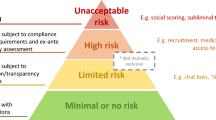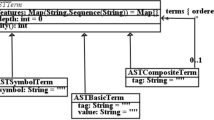Abstract
Ontology can be considered as a comprehensive knowledge model which enables the developer to practice knowledge, instead of code, reuse. In the development of knowledge-based systems, different modeling languages are employed at different stages of the development process. By using a common modeling language for the knowledge and software models, knowledge instead of software reuse can be achieved. We illustrate the process by first presenting an ontology developed for an industrial domain and then investigate Unified Modeling Language (UML) as an ontology modeling tool. Since any model expressed in UML can be translated into a software model, the transition from the knowledge model to system implementation is better supported with the proposed approach. The industrial domain of selecting a remediation technique for petroleum contaminated sites is adopted for the illustration case study.
Similar content being viewed by others
References
Alexander JH, Freiling MJ, Shulman SJ, Rehfuss S, Messick SL (1987) Ontological analysis: an ongoing experiment. International Journal of Man-Machine studies 26(4):473–485
Baclawski K, Kokar MK, Kogut PA, Hart L, Smith J, Holmes WS, Letkowski J, Aronson ML (2001) “Extending UML to support ontology engineering for the semantic web”. In: Proceedings UML 2001: Fourth International Conference on the Unified Modeling Language, Toronto, Canada
Booch G, Rumbaugh J, Jacobson I (1999) The Unified Modeling Language User Guide. Addison-Wesley
Chan CW (1992) Knowledge Acquisition by Conceptual Modeling. Applied Mathematics Letters Journal 3:7–12
Chan CW (1995) Development and Application of A Knowledge Modeling Technique. Journal of Experimental and Theoretical Artificial Intelligence 7(2):217–236
Chen LL, Chan CW (2001) Ontology Design and Its Application in the Petroleum Remediation Domain. In: Kowalczyk R, Loke SW, Reed NE, Graham G (eds) Advances in Artificial Intelligence: Lecture Notes in Artificial Intelligence, vol 2112. Springer Verlag, pp 16–23
Clancey WJ (1985). Heuristic classification. Artificial Intelligence 27:289–350
Cranefield S, Purvis M (1999) “UML as an ontology modeling language“. In: Proceedings of the Workshop on Intelligent Information Integration, 16th International Joint Conference on Artificial Intelligence (IJCAI-99). http://CEUR-WS.org/Vol.23/cranefield-ijcai99-iii.pdf
Cranefield S, Purvis M (2002) “A UML profile and mapping for the generation of ontology-specific content languages”. The Knowledge Engineering Review 17(1):21–39
Dahlgren K (1988) Naive semantics for natural language understanding. Kluwer Academic, Boston, MA
David JM, Krivine JP, Simmons R (1993) Second Generation Expert Systems. Springer-Verlag, Berlin
Desfray P (2001) “MDA-When a major software industry trend meets our toolset, implemented since 1994”. http://www.objecteering.com, http://www.softeam.fr
Eriksson H, Fergerson RW, Shahar Y, Musen MA (1999) Automatic Generation of Ontology Editors. Twelfth Banff Knowledge Acquisition for Knowledge-based System Workshop, Banff, Alberta, Canada
Flores-Mendez RA, van Leeuwen P, Lukose D (1998) Modeling Expertise using KADS and MODEL-ECS. In: Gaines BR, Musen M (eds) Proceedings of the 11the Knowledge Acquisition for Knowledge-Based Systems Workshop (KAW’98). Banff, Canada, vol 1, p VKM-3:14, April 19–23
Fowler M, Scott K (2000) UML Distilled, Addison Wesley, MA
Geng L, Chen Z, Chan CW, Huang GH (2001) An intelligent decision support system for management of petroleum contaminated sites. Expert Systems with Applications 20:251–260
Ghezzi C, Jazayeri M, Mandrioli D (2003) Fundamentals of Software Engineering. Pearson Education Inc., New Jersey
Gruber T (1992) A translation approach to portable ontology specifications. In: Proceedings of the seventh Banff Knowledge acquisition Knowledge-Based Systems Workshop ’92, Banff Canada, October 11–16, paper no 12
Hendler J, Feigenbaum E (2001) Knowledge is Power: the Semantic Web Vision. In: Zhong N, Yao Y, Liu J, Ohsuga S (eds) Web Intelligence Research and Development: First Asia-Pacific Conference Proceedings, Maebashi City, Japan, October, 18–29
Karp PD (1993) A qualitative biochemistry and its application to the regulation of the trytophan operon. In: Hunter L (ed) Artificial Intelligence and Molecular Biology. AAAI Press/The MIT Press, pp 289–324
McDermott J (1988) Preliminary steps toward a taxonomy of problem-solving methods. In: Marcus S (ed) Automating Knowledge Acquisition for Expert Systems. Kluwer Academic, Boston, MA, pp 225–255
Newell A (1981) The knowledge level. The AI Magazine, Summer issue:1–20
Sims JL, Suflita JM, Russell HH (1992) In-situ bioremediation of contaminated ground water. Ground Water Issue, EPA/540/S-92/003, U.S.EPA, R.S. Kerr Environmental Research Laboratory, Ada, OK, p 11
SMI (1998) Stanford Medical Informatics. The Protege Project. http://wmi-web.stanford.edu/projects/protege/1998
Sowa J (1995) Top-level ontological categories. International Journal of Human-Computer Studies 43(5/6):669–686
van de Velde W, Schreiber G (1997) The future of knowledge acauisition: A European perspective. IEEE Expert December 1:1–3
van der Vet PE, Speel PH, Mars NJI (1995) Ontologies for very large knowledge base in materials science. In: Mars NJI (ed) Towards Very Large Databases. IOR Press
Wang X, Chan CW (2001) Ontology Modeling Using UML. In: Wang Y, Patel S, Johnston RH (eds) Proceedings of 7th International Conference on Object Oriented Information Systems Conference (OOIS 2001), Calgary Canada, pp 59–68
Author information
Authors and Affiliations
Corresponding author
Rights and permissions
About this article
Cite this article
Chan, C. Knowledge and software modeling using UML. Softw Syst Model 3, 294–302 (2004). https://doi.org/10.1007/s10270-004-0057-y
Received:
Accepted:
Published:
Issue Date:
DOI: https://doi.org/10.1007/s10270-004-0057-y




